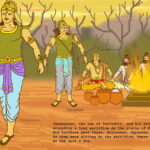Ending of the Parva Sangraha

Note: The last 18 posts have summarized the contents of the 18 parvas of the Mahabharata. Vyasa Muni has narrated 2 more parvas in the appendix (khita). They are known as Harivansha (containing 12000 shlokas) and Vavishya. However, a summary of these parvas has not been provided.
Just to reiterate, eighteen akshauhinis of troops gathered for a terrible battle on the field of Kurukshetra. The intense battle lasted for eighteen days.
It’s interesting how the number 18 keeps coming up in the Mahabharata. 18 parvas, 18 akshauhinis, and 18 days of battle. I don’t know (as yet) if there is any significance to this number. I’ll update the post if I am able to find out.
Vyasa Muni of immense intelligence has said that the Mahabharata is a treatise on artha, dharma, and kama. A person who knows the four Vedas with all the Angas and Upanishads, but does not know this history (Mahabharata), cannot be regarded as wise.
Just as a person who has listened to the sweet sounds of a male kokila bird cannot bear to listen to the sounds of a crow’s cawing, a person who has listened to the Mahabharata cannot bear to listen to other (lesser) histories.
Just like the formation of the three worlds proceeds from the five elements (earth, water, fire air, and space), the inspiration of all poets originates in this excellent epic.
Just like the four kinds of creatures (viviparous, oviparous, born of hot moisture, and vegetables) depend on space for existence, the Puranas depend upon this epic for their existence.
Just like all the senses depend on the modifications of the mind for their exercise, all ceremonial acts and moral qualities depend upon this epic.
Just like the body depends upon the food it has eaten, all stories of this world depend upon this epic.
Servants who desire to rise in the eyes of their employers always attend upon masters of good lineage. Similarly, all poets cherish the Mahabharata (because it is considered to be a work of nobility and good lineage).
Just like the blessed grihasta (domestic) asrama cannot be surpassed by the three other asramas (modes of life), no poet can surpass this poem.
Note: Sauti stresses the following words as he addresses the ascetics of the Naimisha forest. They describe the benefits one can acquire by reading the Mahabharata.
O ascetics, remove inaction from your being, and fix your hearts on virtue because virtue is the only friend you can take with you to the other world (after death). People often desire wealth and wives, but these are not permanent. People who cherish such things, however intelligent they may be, can never make these their own. They can never take their wealth and wives with them to the next world. However, the Mahabharata narrated by Ved Vyasa is unparalleled. It is sacred and virtue itself.
This epic destroys sin and produces good. It is said that the person who listens to this epic does not need to take a bath in the sacred waters of the Pushkara.
Whatever sins a brahmana may have committed during the day are released if he (truly) reads this composition in the evening. Similarly, wherever sins he may have committed during the night are released if he reads this composition at the break of dawn.
People desirous of merit often gift cattle to wise and intelligent brahmanas. However, one can acquire the same merit by reading or listening to the sacred narrations of the Mahabharata.
Note: After describing the benefits of the Mahabharata, Sauti describes the benefits of reading the summaries of the 18 parvas.
Just like the massive ocean can be crossed by those who have ships, this massive history can be read with the assistance of the summaries and this sub-parva known as the Parva Sangraha.”
With this, we end the section called the Parva Sangraha.
Note: If you look at the table of contents, you will notice that the Parva Sangraha began with the post that described the strength of one akshauhini and ends with this post.
In the next post, we will begin the sub-parva of the Adi Parva called the Paushya Parva.
Previous: A Summary of the Svargarohana Parva

